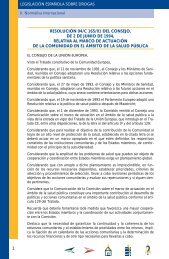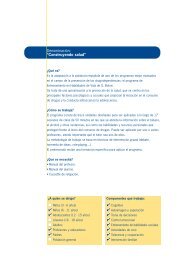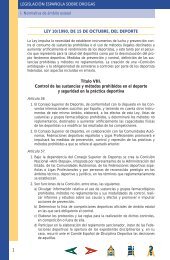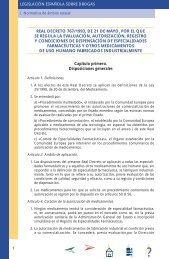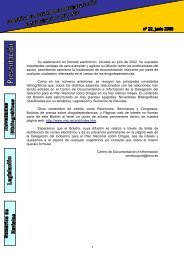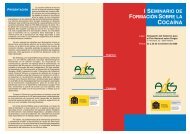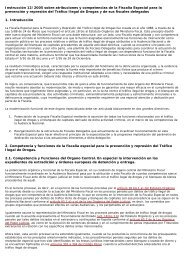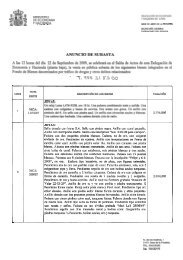Guía para la detección e intervención temprana con menores en ...
Guía para la detección e intervención temprana con menores en ...
Guía para la detección e intervención temprana con menores en ...
You also want an ePaper? Increase the reach of your titles
YUMPU automatically turns print PDFs into web optimized ePapers that Google loves.
Capítulo 1: Definición y <strong>con</strong>cepto de m<strong>en</strong>or <strong>en</strong> riesgo<br />
Russo, M.F., Loeber, R., Lahey, B.B. y K<strong>en</strong>nan, K. (1994). Oppositional deafiant<br />
and <strong>con</strong>duct disorders: validation of the DSM-III-R and an alternative<br />
diagnostic option. Journal of Clinical Child Psychology, 23, 56-68.<br />
Shure, M.B. (2001). I can problem solve (ICPS): An interpersonal cognitive problem<br />
solving program for childr<strong>en</strong>. Resid<strong>en</strong>tial Treatm<strong>en</strong>t for Childr<strong>en</strong> &<br />
Youth, 18, Special Issue: Innovative m<strong>en</strong>tal health interv<strong>en</strong>tions for childr<strong>en</strong>:<br />
Programs that work, pp. 3-14.<br />
Takanishi, R. (1993). The opportunities of adolesc<strong>en</strong>ce. Research, interv<strong>en</strong>tions,<br />
and policy: introduction to the special issue. American Psychologist,<br />
48, 85-87.<br />
Taylor, T.K. y Big<strong>la</strong>n, A. (1998) Behavioral family interv<strong>en</strong>tions for improving<br />
child-rearing: a review of the literature for clinicians and policy makers.<br />
Clinical Child and Family Psychology Review, 1, 41-60.<br />
Taylor, T.K., Eddy, J.M. y Big<strong>la</strong>n, A. (1999). Interpersonal skills training to reduce<br />
aggressive and delinqu<strong>en</strong>t behavior: limited evid<strong>en</strong>ce and the need for<br />
an evid<strong>en</strong>ce-based system of care. Clinical Child and Family Psychology<br />
Review, 2, 169-182.<br />
Walker, H.M., Colvin, G. y Ramsey, E. (1995). Antisocial Behavior at School:<br />
Strategies and Best Practices. Belmont, CA: Brooks/Cole Publishing Co.<br />
Webster-Stratton, C. (1990). Long-term follow-up of families with young <strong>con</strong>duct<br />
problem childr<strong>en</strong>: from preschool to grade school. Journal of Clinical<br />
Child Psychology, 19, 144-149.<br />
Webster-Stratton, C. y Taylor, T. (2001). Nipping early risk factors in the bud:<br />
prev<strong>en</strong>ting substance abuse, delinqu<strong>en</strong>cy, and viol<strong>en</strong>ce in adolesc<strong>en</strong>ce through<br />
interv<strong>en</strong>tions targeted at young childr<strong>en</strong> (0-8 years). Prev<strong>en</strong>tion<br />
Sci<strong>en</strong>ce, 2, 165-192.<br />
Weinberg, N.Z. y G<strong>la</strong>ntz, M.D. (1999). Child psychopathology risk factors for<br />
drug abuse: overview. Journal of Clinical Child Psychology, 28, 290-297.<br />
Weinberg, N.Z., Rahdert, E., Colliver, J.D. y G<strong>la</strong>ntz, M.D. (1998). Adolesc<strong>en</strong>t<br />
substance abuse: a review of the past 10 years. Journal of the American<br />
Academy of Child & Adolesc<strong>en</strong>t Psychiatry, 37, 252-61.<br />
White, H.R., Xie, M., Thompson, W., Loeber, R. y Strouthamer-Loeber, M.<br />
(2001). Psychopathology as a predictor of adolesc<strong>en</strong>t drug use trajectories.<br />
Psychology of Addictive Behaviors, 15, 210-218.<br />
55



